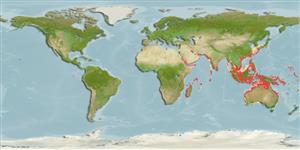>
Dactylopteriformes (Flying gurnards) >
Dactylopteridae (Flying gurnards)
Etymology: Dactyloptena: Greek, daktylos = fingers + Greek, pten, -enos = wing, fin.
Eponymy: Dr Charles Henry Gilbert (1859–1928) was an ichthyologist and fishery biologist, whose main area of study was Pacific salmon. [...] (Ref. 128868), visit book page.
More on author: Snyder.
Environment: milieu / climate zone / depth range / distribution range
Ecología
marino demersal; rango de profundidad 20 - 73 m (Ref. 27821). Temperate
Indo-West Pacific, from southern Red Sea, Somalia and Oman to the Gulf of Thailand and Japan, but not southern Southeast Asia or Australia.
Tamaño / Peso / Age
Maturity: Lm ? range ? - ? cm
Max length : 25.0 cm SL macho / no sexado; (Ref. 559)
Espinas dorsales (total) : 8; Radios blandos dorsales (total) : 8; Radios blandos anales: 6.
Life cycle and mating behavior
Madurez | Reproducción | Puesta | Huevos | Fecundidad | Larva
Eschmeyer, W.N., 1997. A new species of dactylopteridae (Pisces) from the Philippines and Australia, with a brief synopsis of the family. Bull. Mar. sci. 60(3):727-738. (Ref. 27821)
IUCN Red List Status (Ref. 130435: Version 2024-1)
Threat to humans
Harmless
Human uses
Herramientas
Special reports
Download XML
Fuentes de Internet
Estimates based on models
Preferred temperature (Ref.
123201): 24.1 - 28.7, mean 27.7 °C (based on 579 cells).
Phylogenetic diversity index (Ref.
82804): PD
50 = 0.5234 [Uniqueness, from 0.5 = low to 2.0 = high].
Bayesian length-weight: a=0.00646 (0.00318 - 0.01311), b=3.07 (2.88 - 3.26), in cm total length, based on LWR estimates for this species & (Sub)family-body (Ref.
93245).
Nivel trófico (Ref.
69278): 3.5 ±0.5 se; based on size and trophs of closest relatives
Resiliencia (Ref.
120179): Alto, población duplicada en un tiempo mínimo inferior a 15 meses (Preliminary K or Fecundity.).
Fishing Vulnerability (Ref.
59153): Low vulnerability (21 of 100).
